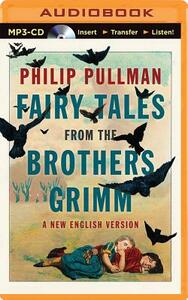Take a photo of a barcode or cover
Started in an airport, finished in an airport. Such a lovely collection of fairy tales!
Grimm Tales For Young and Old pitches between nostalgic and darkly amusing, with the classic tales of Cinderella, Sleeping Beauty and Little Red Riding Hood and some less well-known fairytales like The Mouse, The Bird and The Sausage (lol) and Hans-My-Hedgehog.
With a surprising amount for gore and violence this is probably not one I would ever read to a child, but it maintains the familiar lessons in morality and tropes that were part of all children’s stories.
Here’s what I learned:
1. if someone offers you an easy way out of a taxing task there is probably one hell of a catch
2. be happy with what you have and don’t be greedy
3. be nice to everyone and especially never offend witches
4. if someone tells you not to do something or there will be dire consequences, definitely do not do that thing
5. don’t judge people based on their appearance
6. If it seems too good to be true, it probably is
7. stepmothers may want to kill you
With a surprising amount for gore and violence this is probably not one I would ever read to a child, but it maintains the familiar lessons in morality and tropes that were part of all children’s stories.
Here’s what I learned:
1. if someone offers you an easy way out of a taxing task there is probably one hell of a catch
2. be happy with what you have and don’t be greedy
3. be nice to everyone and especially never offend witches
4. if someone tells you not to do something or there will be dire consequences, definitely do not do that thing
5. don’t judge people based on their appearance
6. If it seems too good to be true, it probably is
7. stepmothers may want to kill you
I liked Philip Pullman's retelling of the stories, it was the actual stories I didn't enjoy. There's nothing more boring than having to read the same four stories in rotation, told in slightly different ways. Fairy tales are an important part of literature and I enjoyed them individually but not the book as a whole. It's definitely not something you should read in one sitting but something to savour over many days.
This is a really lovely collection of fairytales. I enjoyed Philip Pullman's retellings very much. They are written beautifully and in ways I have never seen before. I love that he added some background information on each fairytale, so you know more of where it comes from or its meaning.
I can recommend reading this every winter. It has the perfect feeling for the night and it's always great to read classic fairy tales. Philip Pullman did a great job to research Brothers Grimms tales and I like that I also write so grown-up can read it to.
I didn’t really know what to expect here; I had a big Brothers Grimm collection as a child and I didn’t know if I’d just be bored by silly stories for kids (though I was aware that a lot were more gruesome than you might expect).
I shouldn’t have worried: there’s something about the narrative and style of the stories that makes them easy to read but also really interesting. There’s a rhythm to them which draws you along, and Pullman’s commentary gives some interesting insights.
I shouldn’t have worried: there’s something about the narrative and style of the stories that makes them easy to read but also really interesting. There’s a rhythm to them which draws you along, and Pullman’s commentary gives some interesting insights.
All the usual favorites are included in this collection of Fairytales. I particularly enjoyed Philip Pullman's notes on each story, offering interesting insights and enhancing the overall reading experience.
I can recommend reading this every winter. It has the perfect feeling for the night and it's always great to read classic fairy tales. Philip Pullman did a great job to research Brothers Grimms tales and I like that I also write so grown-up can read it to.
As I imagine most readers will, I picked Grimm Tales for Young and Old up because it was by Philip Pullman. However, be aware that there’s not much of the Pullman about this collection, aside from the introduction. Grimm Tales for the Young and Old is a recitation of the classic fairy tales, not so much retellings.
Pullman describes them as “clear as water” retellings, which basically means he’s trying to get to the most basic forms of the tales. This also means that you could look them up on the internet and get about the same experience; it’s the same sort of idea as Neil Gaiman’s Norse Mythology. I just don’t love this as a concept, because those tales are easily accessible now, and what readers are looking for is the spin these talented authors will put on the stories.
Also, without retelling them and building them out, the fairy tales are pretty hard to listen to back to back to back. There’s not a lot of variety to fairy tales. I love fairy tale retellings a lot, but the originals are clear morality tales in most guesses and sexist to the degree they can be difficult to enjoy. It was interesting to revisit original fairy tales since I haven’t done that since high school, but I’d hoped for more.
Don’t read this for retellings, and maybe don’t read it all in one go, but, if you want to revisit some classic fairy tales in basic form, Grimm Tales for Young and Old might work for you.
Pullman describes them as “clear as water” retellings, which basically means he’s trying to get to the most basic forms of the tales. This also means that you could look them up on the internet and get about the same experience; it’s the same sort of idea as Neil Gaiman’s Norse Mythology. I just don’t love this as a concept, because those tales are easily accessible now, and what readers are looking for is the spin these talented authors will put on the stories.
Also, without retelling them and building them out, the fairy tales are pretty hard to listen to back to back to back. There’s not a lot of variety to fairy tales. I love fairy tale retellings a lot, but the originals are clear morality tales in most guesses and sexist to the degree they can be difficult to enjoy. It was interesting to revisit original fairy tales since I haven’t done that since high school, but I’d hoped for more.
Don’t read this for retellings, and maybe don’t read it all in one go, but, if you want to revisit some classic fairy tales in basic form, Grimm Tales for Young and Old might work for you.
All we need is the word “Once…” and we’re off:
Almost everyone in the Western world grew up with tales like Little Red Riding Hood, Snow White, Cinderellaand Hansel and Gretel and know that whatever watered down version of it they’ve heard, be it Disney or a picture book, is based on Grimm’s collection of Fairy Tales.
I’ve never read the original tales and I had certainly never heard of most of the ones written in Grimm Tales. In that sense, it was really interesting to dive into them and finally know what the big deal is, and I was especially intrigued by the concept of them being rewritten or annotated by Philip Pullman.
As I’ve mentioned before, I’m not a huge fan of short stories and while I found these tales interesting, it’s still hard to get used to a format where a story only takes a few pages and is often not as fleshed out or as developed as they could/should be (which Pullman himself says many times). It took me a lot longer than I was expecting to read this book because I found myself needing to stop after each story to “cleanse my palette” as such, before I could begin the next one.
Growing up, I’d believed, based on the fairy tales I’d heard, that they were all lectures on morality to teach kids not to steal, avoid mean old ladies and not talk to strangers. I was really surprised to discover then that the first quarter of the stories had no moral lesson whatsoever, in fact the bad guy, be they a thief, murderer, liar, trickster or gambler, always came out on top.
From Pullman’s notes: His (Charles Perrault) version differs from Grimm mainly in that it ends with the wolf eating Little Red Riding Hood. There is no rescue by a brave huntsman; instead, a moralistic verse warns that not all wolves are wild – some of them are smooth – talking seducers.
I was also really surprised by the number of stories that required beheading your children or wife in order to return someone to their human form. I mean, normally when a bird comes up to me and says “If you behead all three of your children, your wife will come back” I’m not taking the word of a bird who by all accounts should not even be talking. I’d atleast be asking a few follow up questions “How do you know? Are you secretly an evil witch? Are you really my wife that got transformed into a bird without my knowing?” Step mothers also have a horrible reputation; there is not a single one who does not plot to have the step children murdered and they’re not even that nice to the husbands either.
It’s hard for a storyteller to make an attractive character out of a meek and docile victim who doesn’t argue or fight back once; but then, this isn’t a novel.
The most interesting part for me was Pullmans interpretations and notes on the stories. It was fascinating to see how different countries had developed very similar stories – there were often similar Italian fables for instance – and how the stories had evolved over time. I liked seeing the parts that he’d changed, and more importantly why he felt they needed changing, and the parts that he would have liked to change to make for better storytelling.
I’m fond of this tale (The Musicians of Bremen) because of the simplicity and power of its form. When a tale is shaped so well that the line of the narrative seems to have been able to take no other path, and to have touched every important event in making for its end, one can only bow with respect for the teller.
Almost everyone in the Western world grew up with tales like Little Red Riding Hood, Snow White, Cinderellaand Hansel and Gretel and know that whatever watered down version of it they’ve heard, be it Disney or a picture book, is based on Grimm’s collection of Fairy Tales.
I’ve never read the original tales and I had certainly never heard of most of the ones written in Grimm Tales. In that sense, it was really interesting to dive into them and finally know what the big deal is, and I was especially intrigued by the concept of them being rewritten or annotated by Philip Pullman.
As I’ve mentioned before, I’m not a huge fan of short stories and while I found these tales interesting, it’s still hard to get used to a format where a story only takes a few pages and is often not as fleshed out or as developed as they could/should be (which Pullman himself says many times). It took me a lot longer than I was expecting to read this book because I found myself needing to stop after each story to “cleanse my palette” as such, before I could begin the next one.
Growing up, I’d believed, based on the fairy tales I’d heard, that they were all lectures on morality to teach kids not to steal, avoid mean old ladies and not talk to strangers. I was really surprised to discover then that the first quarter of the stories had no moral lesson whatsoever, in fact the bad guy, be they a thief, murderer, liar, trickster or gambler, always came out on top.
From Pullman’s notes: His (Charles Perrault) version differs from Grimm mainly in that it ends with the wolf eating Little Red Riding Hood. There is no rescue by a brave huntsman; instead, a moralistic verse warns that not all wolves are wild – some of them are smooth – talking seducers.
I was also really surprised by the number of stories that required beheading your children or wife in order to return someone to their human form. I mean, normally when a bird comes up to me and says “If you behead all three of your children, your wife will come back” I’m not taking the word of a bird who by all accounts should not even be talking. I’d atleast be asking a few follow up questions “How do you know? Are you secretly an evil witch? Are you really my wife that got transformed into a bird without my knowing?” Step mothers also have a horrible reputation; there is not a single one who does not plot to have the step children murdered and they’re not even that nice to the husbands either.
It’s hard for a storyteller to make an attractive character out of a meek and docile victim who doesn’t argue or fight back once; but then, this isn’t a novel.
The most interesting part for me was Pullmans interpretations and notes on the stories. It was fascinating to see how different countries had developed very similar stories – there were often similar Italian fables for instance – and how the stories had evolved over time. I liked seeing the parts that he’d changed, and more importantly why he felt they needed changing, and the parts that he would have liked to change to make for better storytelling.
I’m fond of this tale (The Musicians of Bremen) because of the simplicity and power of its form. When a tale is shaped so well that the line of the narrative seems to have been able to take no other path, and to have touched every important event in making for its end, one can only bow with respect for the teller.





